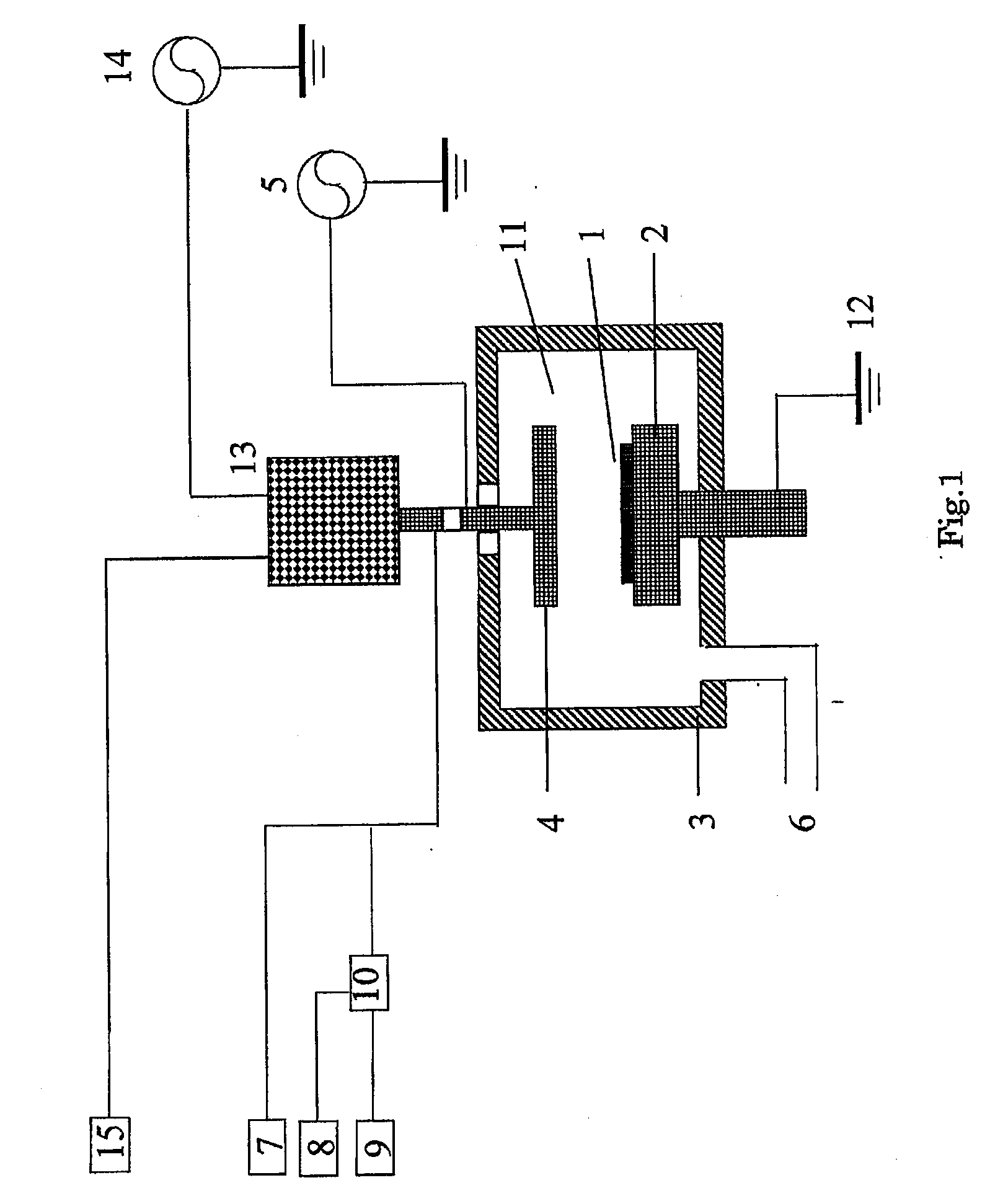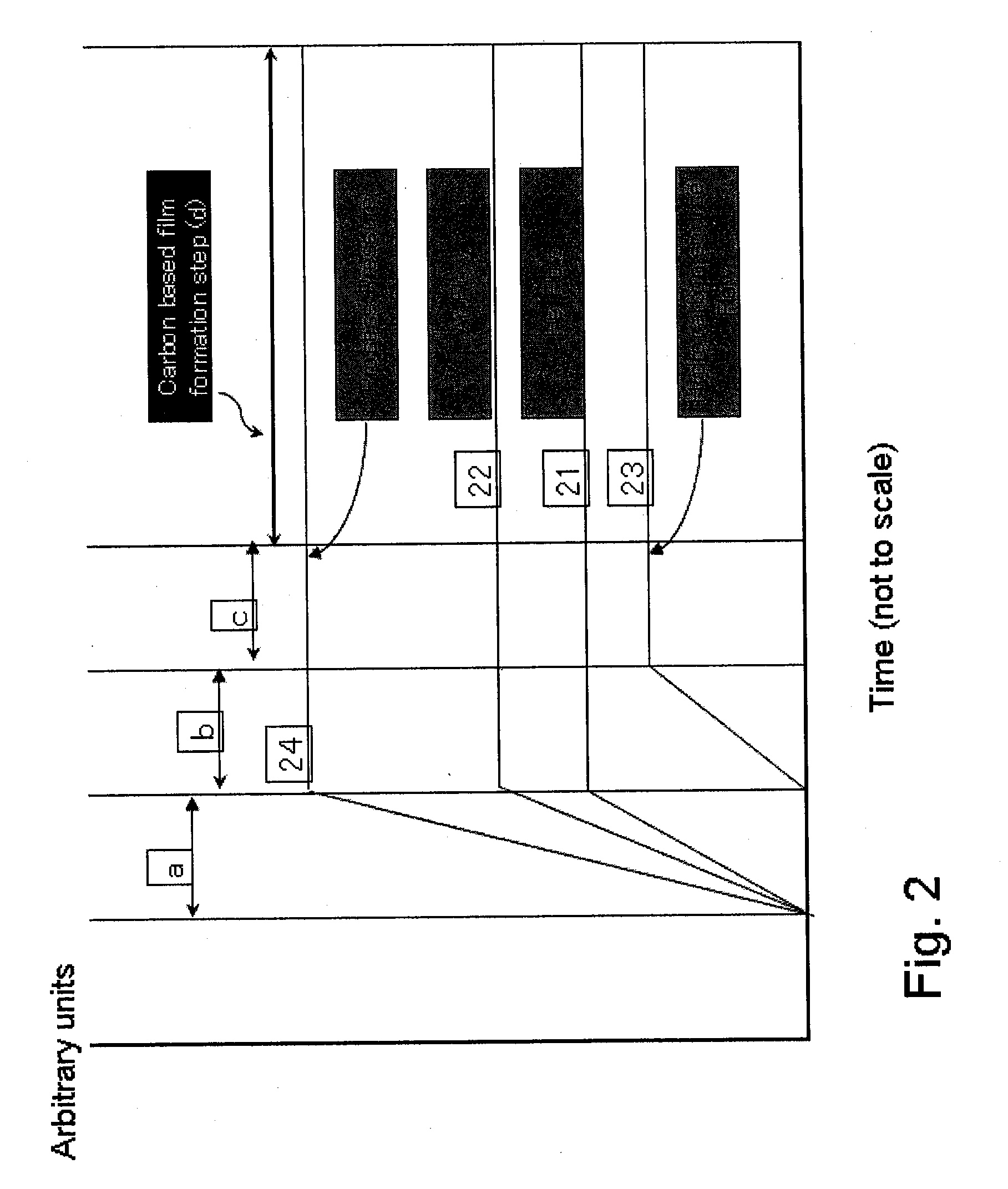Method of forming hardmask by plasma CVD
- Summary
- Abstract
- Description
- Claims
- Application Information
AI Technical Summary
Benefits of technology
Problems solved by technology
Method used
Image
Examples
example 1
Comparative
[0092]Process conditions in this example and film formation results are shown as follows: In this example, a non-aromatic hydrocarbon, cyclopentene, was used as a hydrocarbon precursor.
TABLE 5Process parameter and set points:ParametersBasic film forming StepCyclopentene120 sccmHe400 sccmAr2000 sccmProcess Pressure500 PaHRF Power1800 WSubstrate Temperature340° C.Electrode spacing16 mm
[0093]He supplied to vaporizer: 500 sccm
[0094]Temperature of vaporizer, vaporizer portion: 150° C.
[0095]Controlled temperature of gas inlet piping: 150° C.
[0096]Film Formation Results:
[0097]Thickness: 200±10 nm
[0098]Refractive Index (RI)(n)@633 nm: 1.89
[0099]Extinction coefficient (k)@633 nm: 0.08
[0100]Film Stress: −338 MPa
[0101]Modulus: 43.20 GPa
[0102]Hardness: 6.3 GPa
[0103]The film formed using above conditions shows fairly good film properties. However, it has a poor film stress performance.
example 2
[0104]Process conditions in this example were the same as in Example 1 except that the hydrocarbon source was changed to mesitylene.
TABLE 6Process parameter and set points:ParametersBasic film forming StepMesitylene120 sccmHe400 sccmAr2000 sccmProcess Pressure500 PaHRF Power1800 WSubstrate Temperature340° C.Electrode spacing16 mm
[0105]Film Formation Results:
[0106]Thickness: 200±10 nm
[0107]RI(n)@633 nm: 1.8
[0108]Extinction coefficient (k)@633 nm: 0.04 (see FIG. 4)
[0109]Film Stress: −174 MPa
[0110]Modulus: 34.3 GPa
[0111]Hardness: 5.14 GPa
[0112]The film formed using an embodiment of the present invention (Example 2) shows excellent film properties as a hardmask. Furthermore, the film stress is relatively low such as below 200 MPa which is believed to be strongly dependent on the structure of the hydrocarbon source.
examples 3-5
[0113]In addition to the basic film properties, the films are characterized by a function of film stress and line profile. Carbon-based polymer films were formed in a manner similar to those used in Examples 1 and 2 as follows:
TABLE 7Process parameter and set points of Example 3 (Comparative)ParametersBasic film forming StepCyclopentene120 sccmHe400 sccmAr3000 sccmProcess Pressure500 PaHRF Power2500 WSubstrate Temperature340° C.Electrode spacing16 mm
[0114]The obtained film had a film stress of −400 MPa.
TABLE 8Process parameter and set points of Example 4ParametersBasic film forming StepMesitylene120 sccmHe400 sccmAr3000 sccmProcess Pressure500 PaHRF Power2500 WSubstrate Temperature340° C.Electrode spacing16 mm
[0115]The obtained film had a film stress of −200 MPa.
TABLE 9Process parameter and set points of Example 5ParametersBasic film forming StepMesitylene120 sccmHe400 sccmAr3500 sccmProcess Pressure500 PaHRF Power2500 WSubstrate Temperature340° C.Electrode spacing16 mm
[0116]The obt...
PUM
| Property | Measurement | Unit |
|---|---|---|
| Temperature | aaaaa | aaaaa |
| Thickness | aaaaa | aaaaa |
| Thickness | aaaaa | aaaaa |
Abstract
Description
Claims
Application Information
 Login to View More
Login to View More - R&D
- Intellectual Property
- Life Sciences
- Materials
- Tech Scout
- Unparalleled Data Quality
- Higher Quality Content
- 60% Fewer Hallucinations
Browse by: Latest US Patents, China's latest patents, Technical Efficacy Thesaurus, Application Domain, Technology Topic, Popular Technical Reports.
© 2025 PatSnap. All rights reserved.Legal|Privacy policy|Modern Slavery Act Transparency Statement|Sitemap|About US| Contact US: help@patsnap.com



